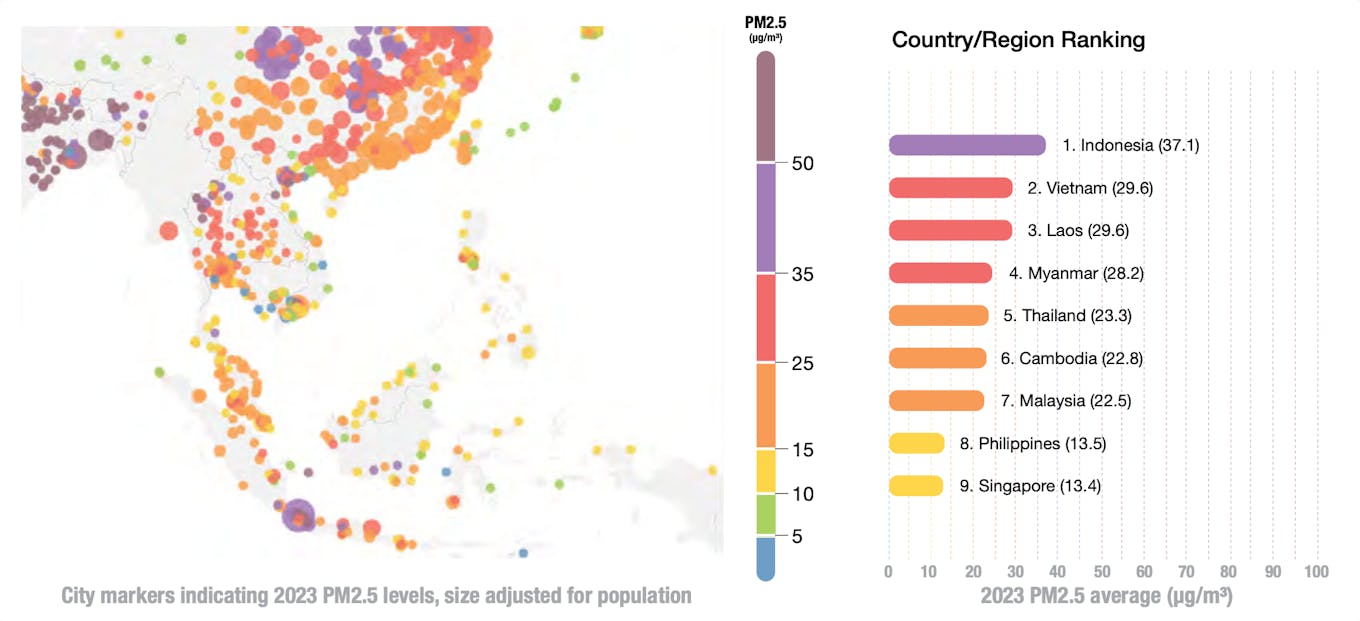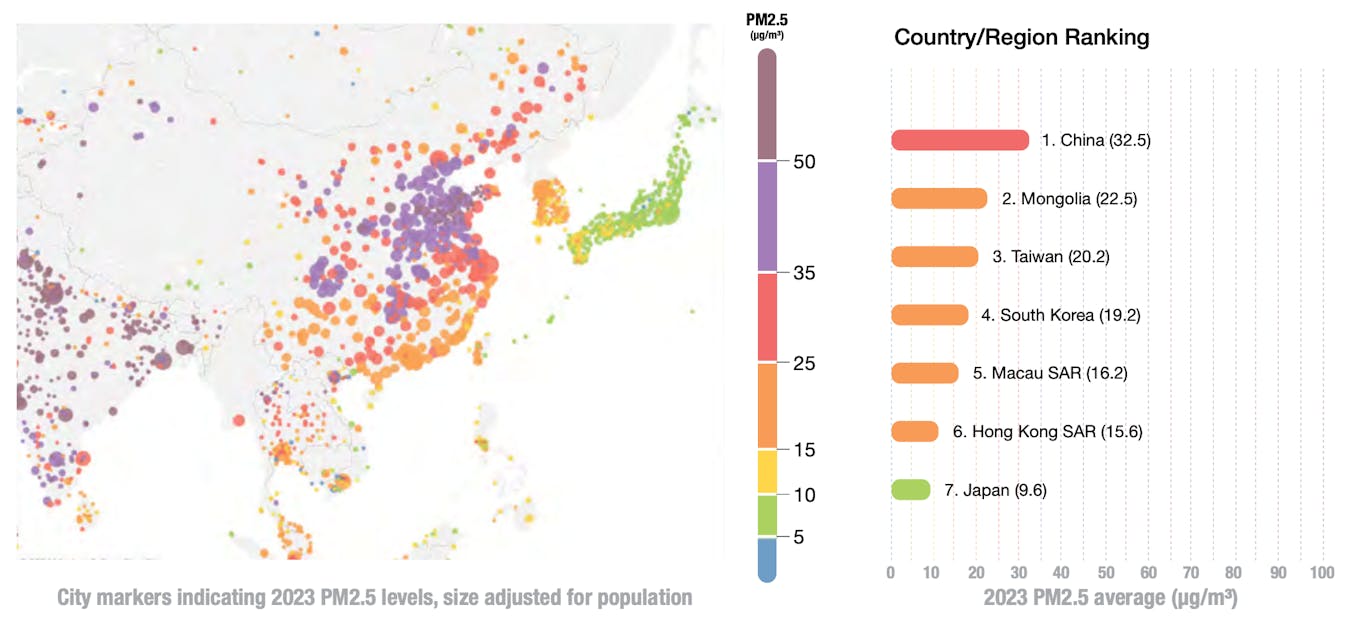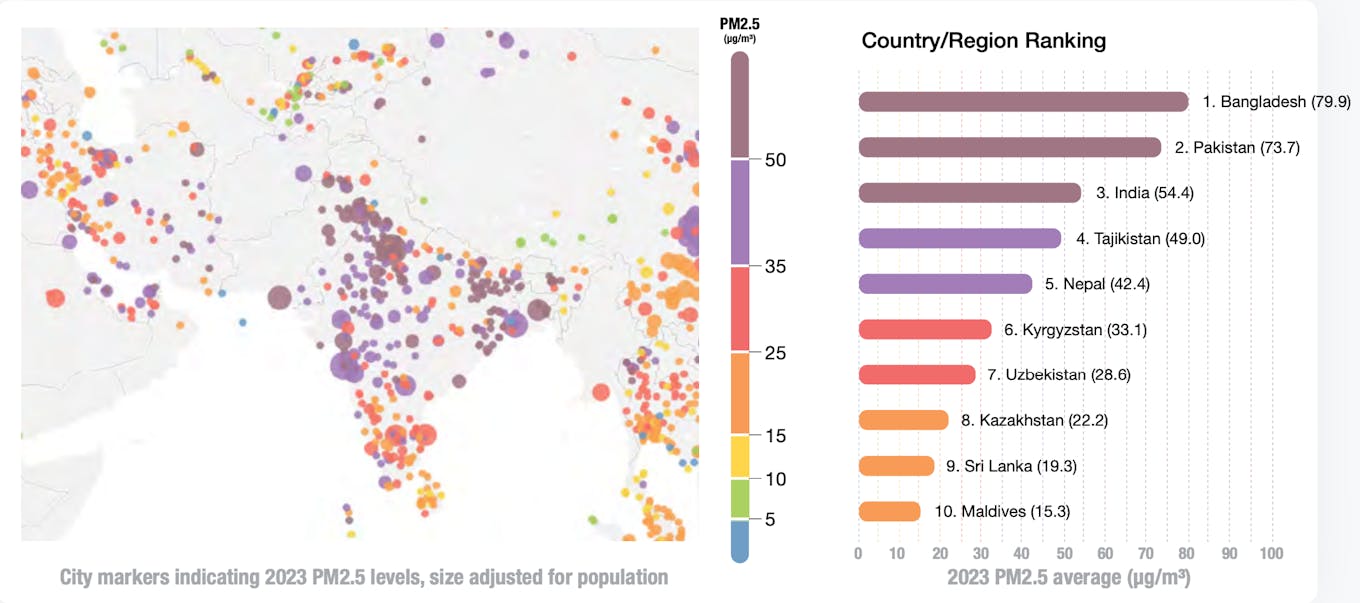Air quality in Southeast Asia worsened significantly in 2023, a year when transboundary haze exacerbated by the El Niño weather phenomenon, proliferating coal power and vehicle emissions contributed to increasing particulate matter pollution (PM2.5) in eight out of nine countries studied by environmental tech firm IQAir.
IQAir tracks PM2.5 data from citizens who use its air quality monitors. PM2.5 is particle matter measuring up to 2.5 micrometres in diameter or smaller that can penetrate deep into the lungs, causing health problems such as heart disease, asthma, and low birth weight.
Only three out of 357 Southeast Asian cities met the World Health Organisation’s (WHO) PM2.5 public health guideline of no more than 5 micrograms of particulate pollution per cubic metre (µg/m3) in 2023 – down from eight regional cities in 2022.
The Philippines was the only Southeast Asian nation to record better air quality in 2023 than in 2022, with a 10 per cent drop in PM2.5 levels.
Indonesia was by some margin Southeast Asia’s most polluted country in 2023, a year when average particulate pollution increased by 20 per cent.
The sprawling archipelago is home to Southeast Asia’s most polluted city, capital Jakarta, where pollution levels are on average more than 20 times above the level deemed safe to breathe by WHO, as well as the regional bloc’s cleanest, the mountainous West Sulawesi city of Mamuju, where pollutions levels are on a par with some Scandinavian countries.
Seven cities in Indonesia, Vietnam – home to the region’s second most polluted city, Hanoi – and Thailand – which was hit by severe haze from agricultural burning in its northen regions – exceeded the WHO annual PM2.5 guideline recommended levels by more than ten times in 2023, compared to 2022 when no city exceeded an annual average of 50 µg/m3.
Singapore was Southeast Asia’s least polluted country, albeit with average pollution levels of 13.4 µg/m3 – more than four times above WHO’s safe benchmark.
PM2.5 levels nearly tripled in Cambodia, increased by 30 per cent in Malaysia, 28 per cent in Thailand, and 9 per cent in Vietnam last year.
El Niño conditions delaying the onset of the rainy season and its mitigating impact on PM2.5 levels were cited as among the main reasons for the pollution spike in Southeast Asia. Primary pollution sources included power generation, industry, road traffic, and open burning.
Chronic bad air quality prompted the Association of Southeast Asian Nations (ASEAN) to set up a special unit to tackle air pollution last year. Environmental group Greenpeace called on the region’s governments to introduce domestic laws to combat transboundary air pollution so that companies linked to cross-border smog are held to account.

Indonesia had the dirtiest air in Southeast Asia last year, while Singapore had the cleanest. Source: IQAir
China’s impressive pollution control track-record ends
China has been championed as a global case study for effective pollution control in recent years, particularly in its capital, Beijing. But the world’s largest greenhouse gas emitter’s five-year historic trend of declining PM2.5 concentrations ended in 2023 with a 6.3 per cent national increase in particulate pollution.
Thick smog returned to Beijing in 2023, where citizens experienced a 14 per cent increase in the annual average PM2.5 concentration.
Some 70 per cent of China’s emissions can be attributed to coal power, with dust storms, industrial activity, household solid biomass fuel burning and transport adding to the smog.
China increased approvals for coal-powered power plants in 2023, with 243 gigawatts of coal-fired capacity permitted or under construction – a trend that jars with the country’s ambition to achieve net-zero emissions by 2060.
Elsewhere in East Asia, Japan, South Korea, Taiwan – which saw the biggest jump in air pollution in East Asia –Hong Kong and Macau all recorded deteriorating air quality in 2023.

All of East Asia’s top 15 most-polluted cities in 2023 are in China, with Hotan in the arid Tarim Basin region of southwestern Xinjiang, the regional bloc’s most polluted city. Source: IQAir
World’s most polluted region – South Asia – gets more polluted
Almost two-thirds (31 per cent) of South and Central Asia’s cities recorded PM2.5 concentrations of more than 10 times WHO’s recommended levels – a level that greatly exceeds any other region in the report.
Bangladesh is the region’s – and world’s – most polluted country overall. The country’s annual average PM2.5 concentration rose to 79.9 µg/m3 in 2023, marking the first increase in pollution since 2018. Pollution in the capital, Dhaka, jumped by 20 per cent last year.
Brick manufacturing is cited as a common form of air pollution in Bangladesh, with surface dust, factories, household cookstoves, plastic trash incineration, and unlined landfills other major sources.
Pollution levels also increased in India, to 54.4 µg/m3, and rose by 10 per cent in New Delhi, the world’s most polluted city, to 92.7 µg/m3 – more than 18 times above WHO’s safe-limit.
Fourteen of the region’s most polluted 15 cities are in India, where industrial emissions, agricultural waste burning, cooking with solid fuels and cremation practices add to the pollution burden.
India’s government banned coal burning for some commerical and industrial businesses in the National Capital Region in January 2023 to try to reduce the smog. However, the country continues to build its coal burning capacity, with a plan to add 17 gigawatts of coal-based power generation to come online over the next 16 months.

All four of the most polluted countries in the world in 2023 were in Central and South Asia; Bangladesh, India, Tajikistan, and Pakistan. Source: IQAir

















